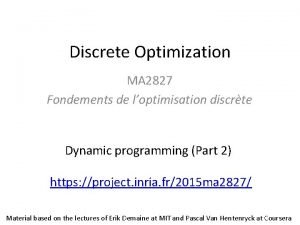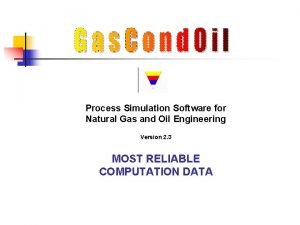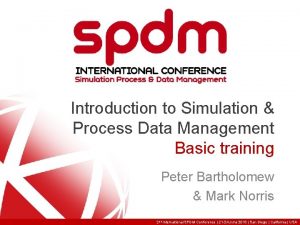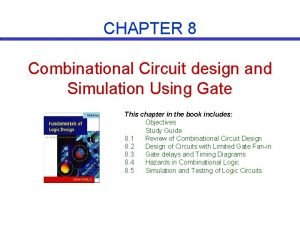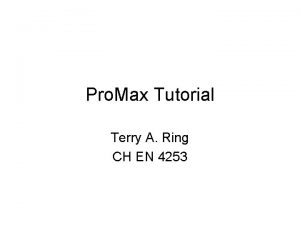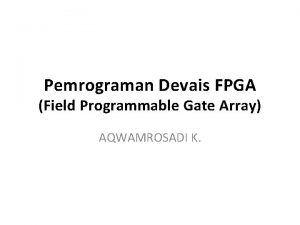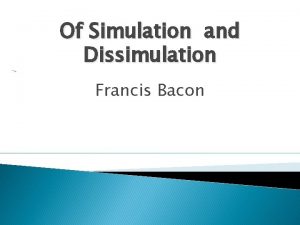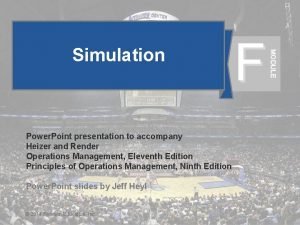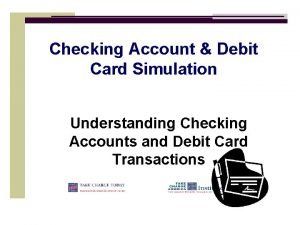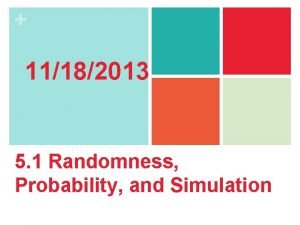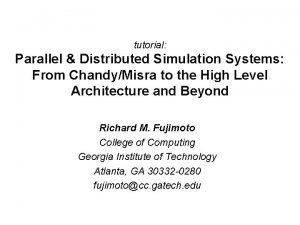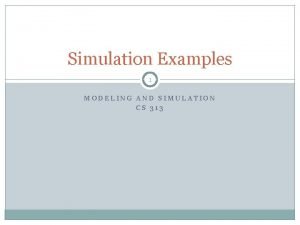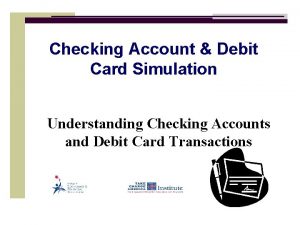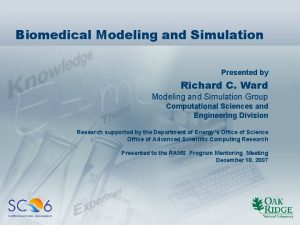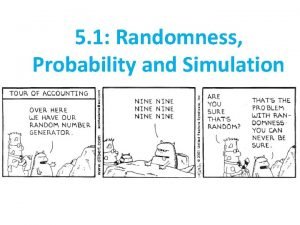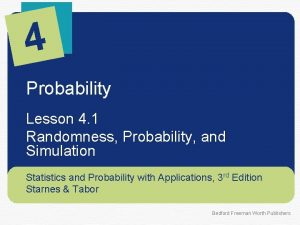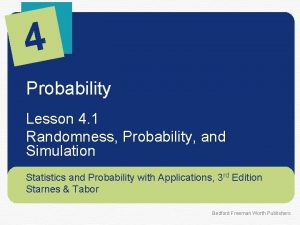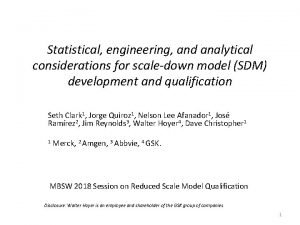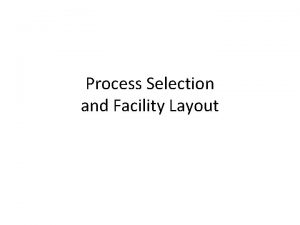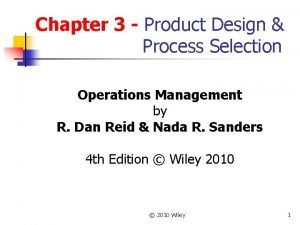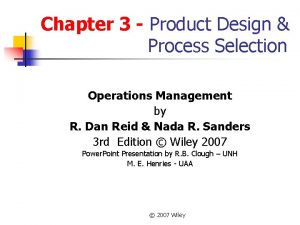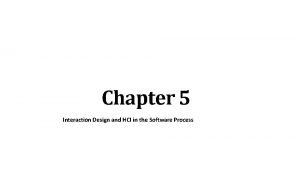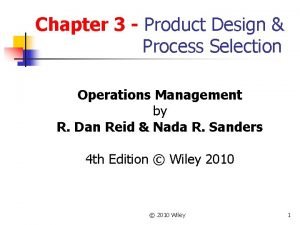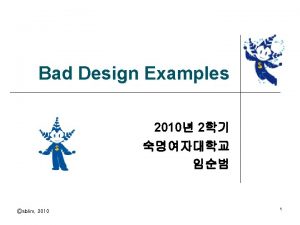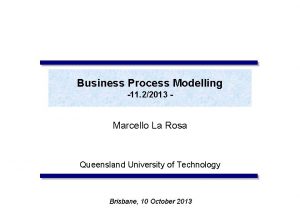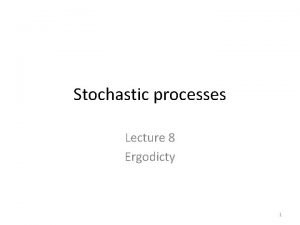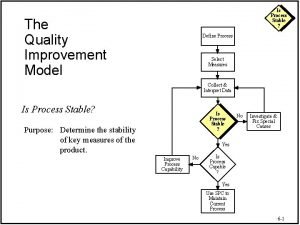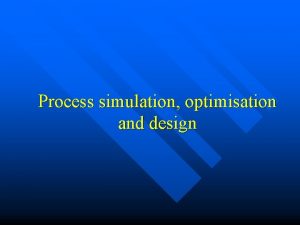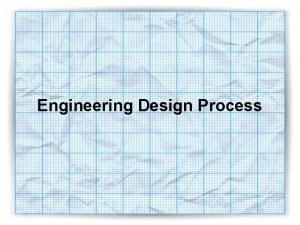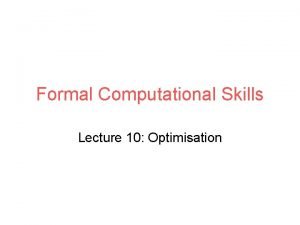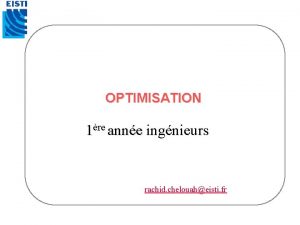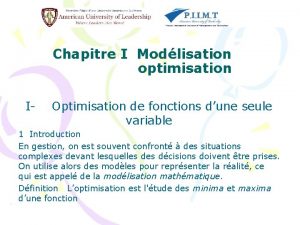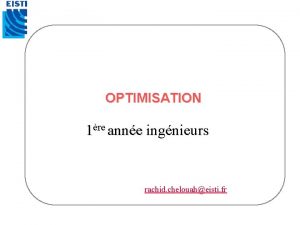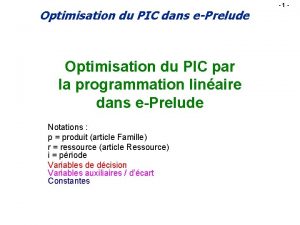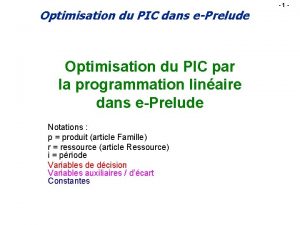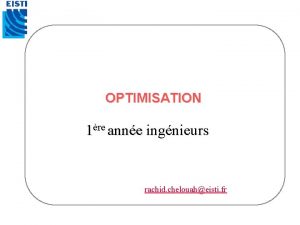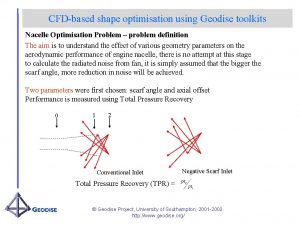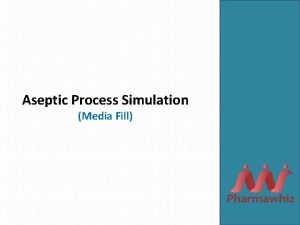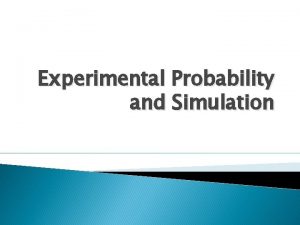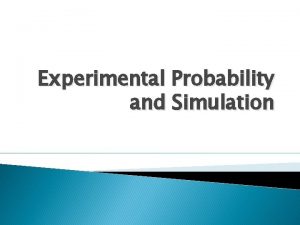Process simulation optimisation and design P S O
















![n Basic operations – Typing: » "normal" – text n n Forced by: [shift]+["] n Basic operations – Typing: » "normal" – text n n Forced by: [shift]+["]](https://slidetodoc.com/presentation_image_h/e237b991978c8ef375ce8b7070ca8fbb/image-17.jpg)
![n Numbers notation – Floating-point notation: 1. 23· 104 Multiplication symbol [*] Superscript (exponent) n Numbers notation – Floating-point notation: 1. 23· 104 Multiplication symbol [*] Superscript (exponent)](https://slidetodoc.com/presentation_image_h/e237b991978c8ef375ce8b7070ca8fbb/image-18.jpg)

![Math. CAD intro n Variables notation – Latin and Greek alphabet ( [ctrl] + Math. CAD intro n Variables notation – Latin and Greek alphabet ( [ctrl] +](https://slidetodoc.com/presentation_image_h/e237b991978c8ef375ce8b7070ca8fbb/image-20.jpg)







![Math. CAD functions n Graphs: – Function of one variable f(x) keys: [f][(][x][)][shift]+[2][x] Math. CAD functions n Graphs: – Function of one variable f(x) keys: [f][(][x][)][shift]+[2][x]](https://slidetodoc.com/presentation_image_h/e237b991978c8ef375ce8b7070ca8fbb/image-28.jpg)














































- Slides: 74

Process simulation, optimisation and design

P. S. O. D. ORGANIZATION ISSUES

Course scope Introduction n Math. CAD n Introduction to CAPE n Simple simulation of heat exchange process using common software n Chem. CAD (by dr Robert Kubica) n

Process simulation, optimisation and design Course objectives

n Provide the students with: – using specialized software for mathematical problems solution – clear understanding of what is a process simulation, a process optimization and process design – using commonly available software to solve simulation problems – using specialized software for process simulation

Lectures are available on the web address www. chemia. polsl. pl/~jkocurek/Studenci. html

Introduction

All the simulation related issues requires

A Model, what is it? n A model is a representation of some aspects of real world objects by: – other parameters easier to measure – scaled down objects – equations and numbers – mathematical models

The Model, what for? n A good model of the apparatus is needed for: – Apparatus design – Process » simulation » optimization » design n apparatus design can be done with pen and piece of paper but even quite simple process optimization problem needs to involve the computer

Model, how to calculate? n Manually – We need: » Knowledge » Paper and pen » Log tables, slide rule, calculator n Computer supported calculation – We need: » Knowledge » PROGRAM

COMPUTER PROGRAM DEFINITION „Set of instructions in a logical sequence interpreted and executed by a computer enabling the computer to perform a required function; also called software. Programs are the "thought processes" of computers, without which they cannot operate. Programs are written in various languages, to conform with the operating system of particular computers. ”

Computer supported calculation n PROGRAM – Written by user, using programming language: » Low level (assembler) » High level (C, Pascal, Fortran, Basic) – Written by user, using common applications for calculation » Spreadsheets (Excel, Calc) » Mathematical tools (Math. Lab, Math. CAD) – Specialized software for modeling and process simulation (Aspen. One, Pro. SIM, Chem. CAD)

Math. CAD The mathematical tool

Introduction n User interface – Writing cursor '+' – Toolbars » » » » » Calculator – equation symbols Graph – building the charts Matrix – inserting matrix/vectors, matrics operation Calculus – derivatives, integrals, limits, summation, iterated product Symbolic Evaluation Boolean –logical operation Programming Greek – inserting Greek letters – Turn of the Resource center at startup View/Preferences/Startup Options

![n Basic operations Typing normal text n n Forced by shift n Basic operations – Typing: » "normal" – text n n Forced by: [shift]+["]](https://slidetodoc.com/presentation_image_h/e237b991978c8ef375ce8b7070ca8fbb/image-17.jpg)
n Basic operations – Typing: » "normal" – text n n Forced by: [shift]+["] Automatically: after space insertion » "variable" – interpreted by program n Default – The typing modes are identified by style: » Normal – Font is Arial (by default) » Variable – Font is Times (by default) – Assign symbol": =" (keys [: ][=])
![n Numbers notation Floatingpoint notation 1 23 104 Multiplication symbol Superscript exponent n Numbers notation – Floating-point notation: 1. 23· 104 Multiplication symbol [*] Superscript (exponent)](https://slidetodoc.com/presentation_image_h/e237b991978c8ef375ce8b7070ca8fbb/image-18.jpg)
n Numbers notation – Floating-point notation: 1. 23· 104 Multiplication symbol [*] Superscript (exponent) [^] Key sequence: [1][. ][2][3][*][1][0][^][4]

Math. CAD intro n Algebraic expressions – +, -, / +, -, , *(not always needed), power [^] – Functions arguments "(. . . )" – Result (evaluation): [=] n Expression typing – standard mathematical notation: [2][/][3][+][3][^][2][ ][l][n][(][3][)][=] or [2][/][3][+][3][^][2][space bar][l][n][(][3][)][=] To go back to basic level press spacebar or right arrow
![Math CAD intro n Variables notation Latin and Greek alphabet ctrl Math. CAD intro n Variables notation – Latin and Greek alphabet ( [ctrl] +](https://slidetodoc.com/presentation_image_h/e237b991978c8ef375ce8b7070ca8fbb/image-20.jpg)
Math. CAD intro n Variables notation – Latin and Greek alphabet ( [ctrl] + [g] after typing Latin letter) – Case sensitivity: x X – Subscripts (not vector/matrix subscripts) [. ] – Prim: x`, bis: x`` etc.

Math. CAD intro n Assigning values and expressions (Pascal like) – One value assigned to one variable: x: =5 keys: [x][: ][5] – Range of arithmetic progression assigned to variable » Default step: x: =0. . 3 (means numbers 0, 1, 2, 3) keys [x][: ][0][; ][3] » Defined step: x: =0, 2. . 6 (means numbers 0, 2, 4, 6) keys [x][: ][0][, ][2][; ][6] Has to be defined earlier – Expression to variable: y: =2·x+3 keys: [y][: ][2][*][x][+][3]

Math. CAD intro Correct Incorrect

Math. CAD intro n The expressions edition – To change the position of edited place press space bar Vertical line: shows place of insertion of a sign Horizontal: shows range will be inserted into function etc.

Math. CAD functions n n Standard functions set Functions definition – Syntax: Function. Name(arg 1, arg 2, . . . ): = expression – E. g. f(x, y)=x·y keys: [f][(][x][y][)][: ][x][*][y] n Calculations with use of defined (or predefined) functions: – – – Evaluation for constants Evaluation for defined variables Evaluation for range of constants (vectors)

Math. CAD functions n Function of constant (scalar)

Math. CAD functions n Function of variable Global variable Local variable

Math. CAD functions n Range of arithmetic sequence (or vector)
![Math CAD functions n Graphs Function of one variable fx keys fxshift2x Math. CAD functions n Graphs: – Function of one variable f(x) keys: [f][(][x][)][shift]+[2][x]](https://slidetodoc.com/presentation_image_h/e237b991978c8ef375ce8b7070ca8fbb/image-28.jpg)
Math. CAD functions n Graphs: – Function of one variable f(x) keys: [f][(][x][)][shift]+[2][x]

Math. CAD functions n Graphs: – Default independent values range: -10 ÷ 10 – Can be edited

Math. CAD functions n Graphs: – Several functions of one independent variable range: f(x), g(x)@x keys: [f][(][x][)][, ] [g][(][x][)][shift]+[2][x]

Math. CAD functions n Graphs: – Several functions of several different independent variable range: f(x), g(z)@x, z keys: [f][(][x][)][, ] [g][(][z][)][shift]+[2][x][, ][z]

Math. CAD functions n Graphs formatting:

Math. CAD functions n Graphs formatting:

Math. CAD functions

Math. CAD functions Show markers enabled

Math. CAD – vectors and matrix Matrix variable definition n vector – one column matrix n

Math. CAD – vectors and matrix

Math. CAD – vectors and matrix n Matrix operations – – – Multiply by constant Matrix transpose [ctrl]+[1] Inverse [^][-][1] Matrix multiplying Determinant

Math. CAD – vectors and matrix n To read the matrix elements Ar, k: key [[] rrow nr, k – column nr – e. g. element A 1, 1 keys: [A][[][1][, ][1][=] n To chose matrix column – First column A( A<0>): keys [A][ctrl]+[6][0] – Default first column number is 0, (to change : Math/Options/Array Origin)

Math. CAD – vectors and matrix n Calculations of dot product and cross product of vectors

Math. CAD – vectors and matrix n Special definition of matrix elements as a function of row-column number Mi, j=f(i, j) – E. g. Value of element is equal to product of column and row number

n Math. CAD 3 D graphs of function on the base of matrix : [ctrl]+[2][M] – M – matrix defined earlier RESTICTION: function arguments have to bee integer type

Math. CAD 3 D graphs n 3 D Graphs of function of real type arguments – Using procedure: Create. Mesh(function, lb_v 1, ub_v 1, lb_v 2, ub_v 2, v 1 grid, v 2 grid) – Assign result to variable – Plot of the variable like plot of matrix ([ctrl]+[2]) Boundaries can be the real type numbers. (def. – 5, 5) Grids have to be integer type numbers (def. 20)

Math. CAD 3 D graphs

Math. CAD 3 D graphs - formating

Math. CAD 3 D graphs – formatting: fill options

Math. CAD 3 D graphs – formatting: fill options Contours colour filled

Math. CAD 3 D graphs – formatting: line options

Math. CAD 3 D graphs – formatting: Lighting

Math. CAD 3 D graphs – formatting: Fog and perspective

Math. CAD 3 D graphs – formatting: Backplane and Grids

Predefined constants n n n e = 2, 718 – natural logarithm base g = 9, 81 m 2/s – acceleration of gravity = 3, 142 – circle perimeter/diameter ratio

Math. CAD equation solving n Single equation (one unknown value) 1. Given-Find method » » Input start point of variable Type "Given" Type equation with using [=] ([ctrl]+[=]) Type Find(variable)=

Math. CAD equation solving n Given-Find – solving methods – – Linear (function of type c 0 x 0 + c 1 x 1 +. . . + cnxn) – starting point do not affects on results, it only defines size of matrix/vector of the solution. Nonlinear – according to nonlinear equation. Obtained result could depend on starting point. Available methods: » » n Conjugate Gradient Quasi – Newton Levenberg-Marquardt Quadratic The choice of method is automatic by default. User can choose method from the pop-up menu over word Find.

Math. CAD equation solving n Single equation (one unknown value) 2. Root procedure: Root(function, variable, low_limit, up_limit)= – Values of function at the bounds must have different signs or

Math. CAD equation solving n Single equation (one unknown value) 2. Root procedure methods: 1. Secant method 2. Mueller method y 1 x 2 y 3 y 2 x 3 x 5 x 4 x 1

n Math. CAD equation solving Single equation (one unknown value) 3. Special procedure: polyroots for the polynomials. Argument of procedure is a vector of polynomial coefficients (a 0, a 1. . . ). The result is a vector too. Methods: 1. Laguerre's method 2. companion matrix 3.

Math. CAD, the system of equations solving n The system of linear equations – Solving on the base of matrix toolbar: » Prepare square matrix of equations coefficients (A) and vector of free terms (B) » Do the operation x: =A-1 B and show result: x= Or » Use the procedure LSOLVE: lsolve(A, B)=

Math. CAD, the system of equations solving

Math. CAD, the system of equations solving n The system of nonlinear equation – Can be solved using given-find method » Assign starting values to variables » Type Given » Type the equations using = sign (bolded) » Type Find(var 1, var 2, . . . )=

Math. CAD, the system of equations solving

Differential equations solving n Numerical methods: – Gives only values not function – Engineer usually needs values – There is no need to make complicated transformations (e. g. variables separation) – Basic method implemented in Math. CAD is Runge-Kutta 4 th order method.

Differential equations solving n Numerical methods principle – Calculation involve bounded segment of independent variable only – Every point is being calculated on the base of one or few points calculated before or given. – Independent variable is calculated using step: x i+1 = x i + h = x i+ D x – Dependent value is being calculated according to the method

Differential equations solving n Runge-Kutta 4 th order method principles: – New point of integral is being calculated on the base of one point (given/calculated) and 4 intermediate values

Math. CAD differential equations n Single, first order differential equation Initial condition 1. Assign the initial value of dependent variable (optionally) 2. Define the derivative function 3. Assign to the new variable the integrating function rkfixed: R: =rkfixed(init_v, low_bound, up_bound, num_seg, function)

Math. CAD differential equations 4. Result is matrix (table) of two columns: first contain independent values second dependent ones 5. To show result as a plot: R<1>@R<0>

Math. CAD differential equations

Math. CAD differential equations n System of first order differential equations 1. Assign the vector of initial conditions of dependent variables (starting vector) 2. Define the vectoral function of derivatives (right-hand sides of equations) 3. Assign to the variable function rkfixed: R: =rkfixed(init_vect, low_bound, up_bound, num_seg, function)

Math. CAD differential equations 4. Result is matrix (table) of three columns: first contain independent values, 2 nd first dependent values, third second ones : 5. Results as a plot: R<1>, R<2>@ R<0>

Math. CAD differential equations

n Math. CAD differential equations Single second order equation Initial condition 1. Transform the second order equation to the system of two first order equations:

Math. CAD differential equations Example: Solve the second order differential equation (calculate values of function and its first derivatives) given by equation: n While y=10 and y’=-1 for x=0 In the range of x=<0, 1>

Math. CAD differential equations System of equations Starting vector Vectoral function

 Powerstar voltage optimisation
Powerstar voltage optimisation Optimisation plateforme logistique
Optimisation plateforme logistique Ultrasound image optimisation
Ultrasound image optimisation Tetris
Tetris Optimisateur de tournée
Optimisateur de tournée Mobile workforce optimisation
Mobile workforce optimisation Optimisation
Optimisation Roy's identity
Roy's identity Oil and gas process simulation software
Oil and gas process simulation software Simulation process and data management
Simulation process and data management Combinational circuit design and simulation using gates
Combinational circuit design and simulation using gates Combinational circuit design
Combinational circuit design Aerospace systems design and simulation
Aerospace systems design and simulation Split range
Split range Promax process simulation software
Promax process simulation software Simulation process
Simulation process Heat transfer simulation software
Heat transfer simulation software Apakah tujuan dari functional simulation dalam design flow
Apakah tujuan dari functional simulation dalam design flow Quality and innovation in product and process design
Quality and innovation in product and process design For designing
For designing Coronoid process and coracoid process
Coronoid process and coracoid process Condylar and coronoid process
Condylar and coronoid process Simulation kelton
Simulation kelton Of simulation and dissimulation
Of simulation and dissimulation Of simulation and dissimulation by francis bacon summary
Of simulation and dissimulation by francis bacon summary National infrastructure simulation and analysis center
National infrastructure simulation and analysis center Heide abelli
Heide abelli Monte carlo simulation advantages and disadvantages ppt
Monte carlo simulation advantages and disadvantages ppt Debit card simulator
Debit card simulator Randomness probability and simulation
Randomness probability and simulation Parallel and distributed simulation systems
Parallel and distributed simulation systems Examples of simulation
Examples of simulation Pharmaceutical simulation and modeling
Pharmaceutical simulation and modeling Introduction to modeling and simulation
Introduction to modeling and simulation 3-1 checking accounts worksheet answers
3-1 checking accounts worksheet answers Checking account and debit card simulation answers
Checking account and debit card simulation answers Symbolic probability rules
Symbolic probability rules Biomedical modeling and simulation
Biomedical modeling and simulation Randomness probability and simulation
Randomness probability and simulation Randomness probability and simulation
Randomness probability and simulation Randomness probability and simulation
Randomness probability and simulation Contoh proses stokastik dalam kehidupan sehari-hari
Contoh proses stokastik dalam kehidupan sehari-hari Checking account simulation
Checking account simulation Alfred barr
Alfred barr Backhand frisbee
Backhand frisbee Site:slidetodoc.com
Site:slidetodoc.com Simulation of hair appearance and motion download
Simulation of hair appearance and motion download Parts of a check
Parts of a check Checking accounts 101
Checking accounts 101 Algorithm design and analysis process
Algorithm design and analysis process Process modeling in system analysis and design
Process modeling in system analysis and design Disadvantages of facility layout
Disadvantages of facility layout Crm project plan
Crm project plan Titik impas
Titik impas Process selection in operations management
Process selection in operations management How will you make the selection of product design
How will you make the selection of product design Hci chapter 5
Hci chapter 5 Operations management product design
Operations management product design Product design and process selection
Product design and process selection Product design and process selection
Product design and process selection Beprs
Beprs Rational design process
Rational design process Example of decorative design
Example of decorative design 4 types of decorative designs
4 types of decorative designs User interface design in system analysis and design
User interface design in system analysis and design Bad designs examples
Bad designs examples Dialogue design
Dialogue design Substantive vs procedural due process
Substantive vs procedural due process Process hierarchy in process management
Process hierarchy in process management Ergodic process in random process
Ergodic process in random process What is process to process delivery
What is process to process delivery Process capability
Process capability Process-to-process delivery
Process-to-process delivery Sweet process vs process street
Sweet process vs process street Sweet evaluation
Sweet evaluation



